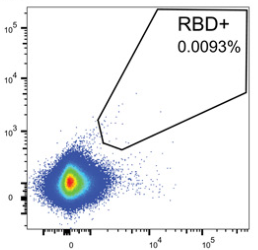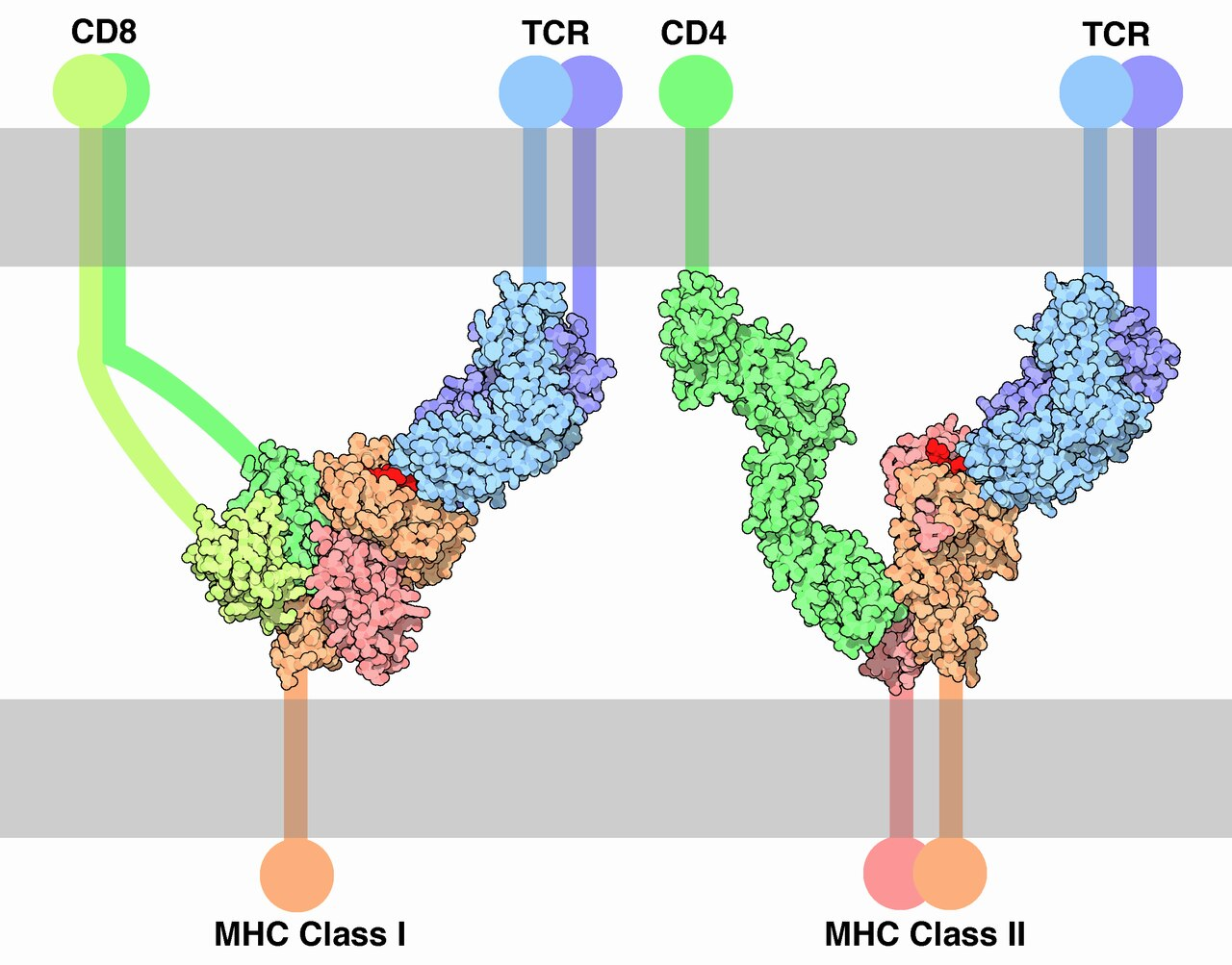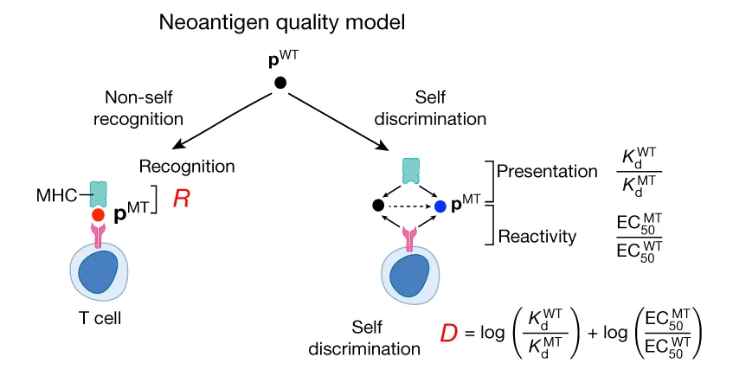Affinities in the immune repertoire
Thomas Dupic
CIML, October 2023





Background

- PhD [Y. Ikhlef and B. Estienne] Conformal Field Theory applied to statistical models
- Post-Doc [A. Walczak and T. Mora] Statistical properties of the immune repertoire
- Post-Doc [M. Desai] Binding affinity landscapes of antibodies
Immune repertoire
B-cells

 V(D)J recombination
V(D)J recombination

T-cells


B-cell and T-cell receptors share:
a similar protein structure
near identical generation mechanisms
extremely high diversity
Immune repertoire diversity
- Immune repertoires contain more than 10⁹ unique B and T-cell receptors
- Only a small fraction of these receptors are shared, most are unique
- This diversity influences the effectiveness of the immune response .

Dupic et al., PLoS Genetics, 2021
Immune repertoire diversity
How is immune receptor diversity generated and regulated?
What is its impact on immune response?
To what extent can we predict immune system reactions?
What is its impact on immune response?
To what extent can we predict immune system reactions?

Outline
- I. Correlation between α and β chains during T-cell receptor rearrangement
- II. Evolution of a broadly neutralising antibody
- III. Affinities in the immune repertoire
V(D)J recombination

T-cell receptor diversity is created during T-cell development.
T-cell receptors are formed by two chains, α and β, both generated by V(D)J recombination.
V(D)J recombination is well understood statistically, and each chain can be represented by a small number of parameters .
T-cell receptors are formed by two chains, α and β, both generated by V(D)J recombination.
V(D)J recombination is well understood statistically, and each chain can be represented by a small number of parameters .
Germline
TCRα gene
V allele
J allele
delV
delJ
insVJ
Marcou et al., Nat Comm., 2018
Sethna, …, Dupic et al., PLoS Comp Bio, 2020
Multi-TCR T-cells
T-cells can have more than one receptor.
α chain
β chain
Chromosome #1
Chromosome #2



But only one-third of all cells have two functional receptors and nearly none have four.
- V(D)J recombination often fails.
- Allelic exclusion on the β chain.

Petrie et al., JEM, 1993
Brady et al., J Immunol., 2010
T-cell Receptor generation

How much do these different recombination process interact with each other ?
Dataset with 10⁷ paired sequences:
- Infer back their recombination process
- Extract out the effects of thymic selection + clonal expansion
- Infer correlations
Howie et al., Sci. Transl. Med., 2015
Correlation between chains
β and α chains are largely independent from one another.
Strong correlation between the two α chains.





Intra-chain
Inter-chains

Dupic et al., Plos Comp. Bio, 2019
Rescue mechanism




Dilution of specificity

For specific antigens, the α and β chains need to be strongly correlated.
But only a very small fraction of the repertoire reacts to a specific antigen, the "interesting" signal is drowned in the noise.

Sethna,…, Dupic et al., PLoS Comp Bio, 2020
Outline
- I. Correlation between α and β chains during T-cell receptor rearrangement
- II. Evolution of a broadly neutralising antibody
- III. Affinities in the immune repertoire
B-cell affinity maturation

- B-cell receptors can mutate post-rearrangement.
- Darwinian selection against specific antigens.
- Can we infer what were the selection pressure from the end result ?
Broadly neutralising antibodies
Broadly neutralizing antibodies offer protection against many variants of a virus but are rarely generated by the immune system.
How did they evolve ?
How did they evolve ?
CR9114 and CR6261
![]()


Throsby et al., Plos One, 2008
Dreyfus et al., Science, 2012
Combinatorial exploration
We recreated all potential intermediate sequences between germline and somatic and measured their affinity toward three antigens H1, H3 , fluB



Adams et al., eLife, 2016
Phillips,…, et al., eLife, 2021
CR9114
Histogram
Force-Directed Layout
65536 measurements
Sequential exposure



Phillips,…, Dupic et al., eLife, 2021
Phillips,…, Dupic et al., eLife, 2022
Conclusion
Affinity measurements can reveal an antibody's history.


They go beyond structural data.
Future directions: in-vitro evolution.
Generations
Generations
Frequency


Binding affinity in proteins
How did SARS-CoV-2 variant Omicron emerge ?
30'000+ Spike protein variants tested against cell receptors and antibodies.


Measurement of binding affinity of germinal center antibodies.
Moulana*, Dupic* et al., Nat Comm, 2022
Moulana*, Dupic* et al., eLife, 2023
Phillips,…,Dupic, eLife, 2023
Outline
- I. Correlation between α and β chains during T-cell receptor rearrangement
- II. Evolution of a broadly neutralising antibody
- III. Affinities in the immune repertoire
Project overview
Immune receptors are crucial for adaptive immunity but their diversity make them challenging to study.
- Develop tools, both experimental (high-throughput affinity measurements) and theoretical (statistical modelling) to help us study the immune repertoire.
- Understand the functional diversity of immune repertoires and its impact on immune response.
- Explore the impact of receptor affinity differences on cell behavior.








High-Throughput affinity measurements
- Select sequences in-silico.
- Library creation
templated V-genes + oligo-pools. - Yeast-display
single-chain variable fragment (scFv) format. - Fluorescence-Activated Cell Sorting (FACS).
- Sequencing of each well.
- Repeat for different concentrations of antigens.
Adams et al., eLife, 2016
Caveats

High precision on binding affinity but:
- Yeast expression pattern / glycosylation
- Proteins are messy
T-cells can also be expressed in scFv format.
Low affinity ⇒ tetramer MHC
Low affinity ⇒ tetramer MHC


Smith et al., Methods Mol. Biol., 2015
Altman et al., Curr. Protoc. Immunol., 2016
B-cell affinity
Antibody affinity spans 6 orders of magnitude; differences in affinity influence qualitatively B-cell behaviour.
But current measurements of affinity are low-throughput or binary.
Can we measure the functional diversity of the B-cell response ?
But current measurements of affinity are low-throughput or binary.
Can we measure the functional diversity of the B-cell response ?
Activated B-cells
activated B-cell are B-cells that have encountered their specific antigen.
 Antigen-reacting cells (flow-cytometry)
Antigen-reacting cells (flow-cytometry) (1‰, 1% of B-cells)
 Cells with activated phenotypes (scRNA-seq)
Cells with activated phenotypes (scRNA-seq) (20% of B-cells)
 Expanding clones (bulk sequencing)
Expanding clones (bulk sequencing) (10% of B-cells)
Hartley et al., Science, 2020
Stephenson et al., Nat. Med., 2021
Horns et al., Cell Reports, 2020
SARS-CoV-2 vaccination
- Rapidly evolving virus
- Important proportion of immunologically naïve individuals (3 years ago)

- RNA vaccine: one, well-characterized antigen
- Massive amount of sequencing and characterisation
Scheid et al., Cell, 2021
Montague et al., Cell Reports, 2021
Stephenson et al., Nat. Med., 2021
Scheid et al., Cell, 2021
Kotagiri et al., Cell Reports, 2022
Kim et al., Nature, 2022
Gregoire et al., Immunity, 2022
Ortega et al., PLOS Genetics, 2023
Tong et al., Cell, 2021
...
Better epitopes
Epitopes play an important role in viral evolution.
Defined via antibody panel and characterized structurally.
Yeast-display experiments can test a broader range of antibodies and define these families more precisely.
Defined via antibody panel and characterized structurally.
Yeast-display experiments can test a broader range of antibodies and define these families more precisely.

Moulana, Dupic et al., Nat. Comm., 2022
Barnes et al., Cell, 2020
Measuring T-cell Affinity
- T-cell receptors generally have lower affinity than antibodies
- They depend on MHC presentation (hence on HLA type)
- Collective effects play a larger role: Quorum Sensing

Neoantigens
Neoantigen are new or mutated proteins produced by cancer cells that can act as target for the immune system.

In pancreatic cancer repertoire-neoantigen correspondence seems to be able to predict immunoediting as well as immunotherapy effectiveness.
Łuksza et al., Nature, 2022
Barnes et al., Cell, 2020
Predicting T-cell / peptide affinity
T-cells receptors / peptide-MHC interaction is simpler than antibody/antigen. But models lack quantitative data.


Collaboration with computational biologists and physicists (Deep Neural Network, Large Language Models, Restricted Boltzmann Machine)
Sethna,…,Dupic et al., Plos Comp. Bio, 2020
Bravi et al., Plos Comp. Bio, 2021
Shugai et al., Nucleic Acids Res., 2018
Conclusion
Quantitative approach with a different experimental toolset.
- To what extent do receptors' affinities influence cell phenotype, immune response and immunoprotection ?
- What is needed to predict receptor affinity in-silico ?
- How much functional variation is there between repertoires ?
Thanks!
